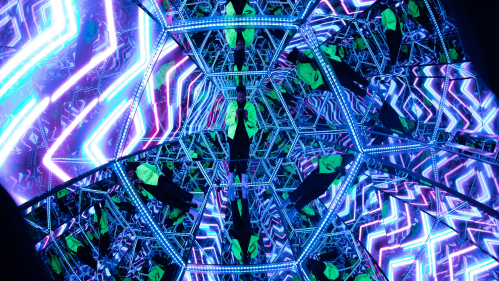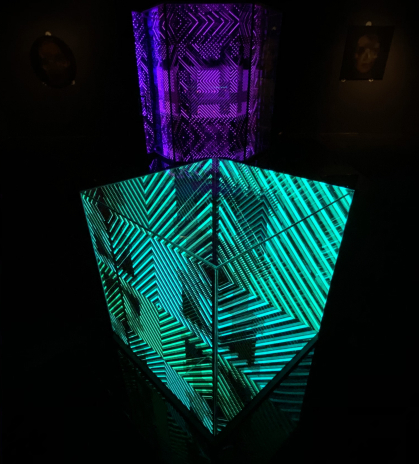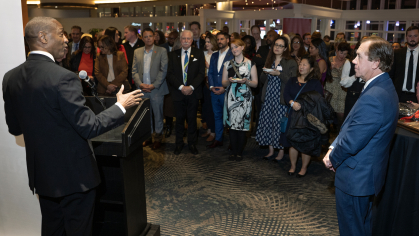Rutgers Alumnus – Shutdown Over COVID-19 – Uses 360 Degree Cameras in Art Installation

Virtual "Vanity"
Mason Gross School of the Arts graduate adjusts New York City show to deliver art safely—and to your couch
Dave Cicirelli knew he had no time to waste. When the artist realized that his Manhattan gallery debut—at the iconic South Street Seaport, no less—would be scuttled due to the spread of COVID-19, he did what any good artist would do: He got creative.
The Mason Gross School of the Arts Department of Art & Design alum switched mediums to get Vanity Project out there safely and quickly during the growing global pandemic—without compromising the original art.
“Initially, I was heartbroken. But in the back of my mind, I always knew the ‘infinity room’ experience was perfect for virtual reality,” said the experiential designer.
The kaleidoscopic Vanity Project, presented by WallPlay Network, is an immersive experience that combines video with specialty glass to create floating light. The infinity cube, a glass sculpture, is observable from the outside, yet once inside, you cannot see out. The effect is moving imagery that layers with the viewer's own reflection and repeats them both endlessly in all directions—resulting in an almost out-of-body experience.
By filming all 360 degrees of the installation at the same time, the experiential designer created a simulated environment to place the at-home viewer inside of Vanity Project.
To make the show work outside the gallery, Cicirelli filmed, edited and stitched together the footage to form two perspectives safely enjoyable in stereoscopic video: the viewer can “walk” through the space and step inside of the infinity cube. In virtual reality, the cube becomes a meditative space where the viewer is surrounded by images of vanity, instead of their own image.
“It was important that the endlessly expanding depth of the cube was captured,” said Cicirelli, whose first breakthrough piece was Fakebook, a 2009 hoax and social experiment that confronted issues of fake news and influencer impact, and the basis of his homonymous book.
Cicirelli transformed Vanity Project into its current form in less than a week. But it wasn’t easy.

After scrambling to track down the necessary equipment – an Insta360 Pro 360 3D camera – he finally located one in upstate New York using KitSplit, a rental marketplace for high-end film equipment. Cicirelli learned on the go as he filmed and worked with unfamiliar editing software.
“The piece speaks to the abundant tension of how people want to perceive themselves and how people put themselves out there,” said Cicirelli, who treats the mirror as a medium both to confront and subvert the excesses of self-image. “We, as humans, want to be seen but want to control how we are seen. I wanted to make that very real.”
Artists everywhere are adapting to this new normal and need to be even more creative during this time, he noted. He hopes his experience will inspire others in similar situations.
“The value of art is to reach people through a medium to make them feel something, which is needed now more than ever,” Cicirelli said. “In a way, current world events have made us more receptive to art. It is a rarer and rarer commodity in our world these days to be able to pause.”
“Designers and artists working with technology are inherently adaptable and able to translate their ideas across varied formats and contexts,” added Jacqueline Thaw, an associate professor in design at Mason Gross who taught Cicirelli. “As an undergrad, he consistently questioned conventions and expectations, and here, he continues. We all need something like this right now—dynamic, expansive, and transporting.”
Cicirelli has a vast background in creating sprawling experiences. As the former creative director at the premier experiential marketing agency, Mirrorball, he developed and designed Jack Daniel’s Motel No. 7 event series and Dos Equis’ Masquerade events.
Last year, Cicirelli opened Rochambeau.xyz, a concept-driven design studio dedicated to bringing new ideas to life, including Vanity Project. The studio has done work with Major League Baseball, the Washington Wizards, Marriott and Amex, among other clients.
Cicirelli is hopeful, once it is safe to do so, that the installation will be available for public view again. For updates, follow @dcicirelli and @wallplaynetwork.
For now, he is excited about sharing the installation in this new medium.
Vanity Project is viewed best with VR goggles but can also be enjoyed on desktops and smartphones. View it here.


